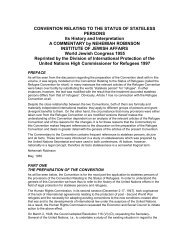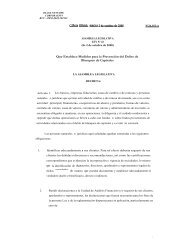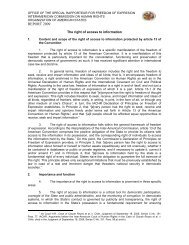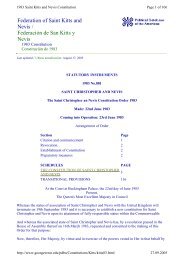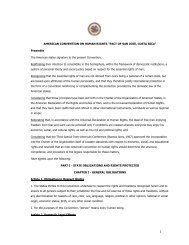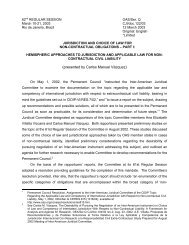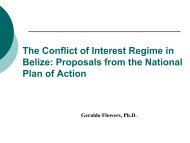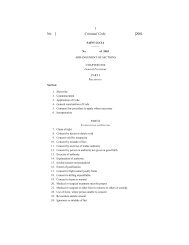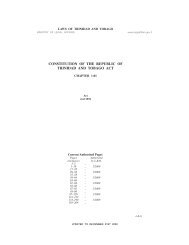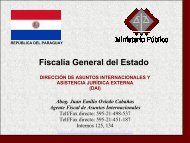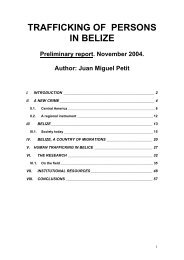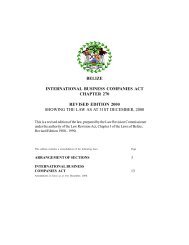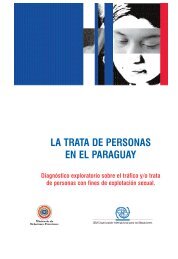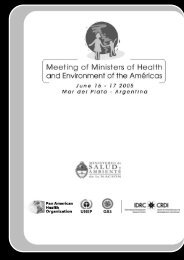Transboundary meeting on environmental protection
Transboundary meeting on environmental protection
Transboundary meeting on environmental protection
Create successful ePaper yourself
Turn your PDF publications into a flip-book with our unique Google optimized e-Paper software.
PART II Identificati<strong>on</strong> of comm<strong>on</strong> problems and protective acti<strong>on</strong>s in the border regi<strong>on</strong><br />
9.35 AM Presentati<strong>on</strong>: Envir<strong>on</strong>mental Threats in the Tumucumaque Regi<strong>on</strong><br />
by Marcelo Segalerba (Amaz<strong>on</strong> C<strong>on</strong>servati<strong>on</strong> Team Brazil)<br />
Marcelo Segalerba presented the envir<strong>on</strong>mental threats in the Northern Brazil area – the<br />
Tumucumaque regi<strong>on</strong>. Marcel Segalerba started with a short introducti<strong>on</strong> about the Tumucumaque regi<strong>on</strong>;<br />
a general view of the threats and envir<strong>on</strong>mental problems in this regi<strong>on</strong> was briefly enlightened. Marcelo<br />
Segalerba stated that the locati<strong>on</strong> of the indigenous communicati<strong>on</strong>s the ACT works is in the<br />
Tumucumaque regi<strong>on</strong>. Marcelo Segalerba then described the study area, the Tumucumaque area. Marcelo<br />
also stated that the particular geological formati<strong>on</strong>s found in the c<strong>on</strong>fluence of the fr<strong>on</strong>tiers of the different<br />
Suriname, Brazil, and French Guyana areas which gives the name of the different z<strong>on</strong>es.<br />
The area descripti<strong>on</strong> could be seen projected <strong>on</strong> a screen. He also showed more of less defined areas by the<br />
indigenous lands (Tumucumaque Indigenous land and Paru Del Este), Tumucumaque Natural Park and a<br />
not well defined area of Suriname and French Guyana.<br />
These threats can be treated as problems. The problems that have to resolved, are sometimes<br />
difficult to understand (e.g. waste without treatment in the villages). These problems also have cause and<br />
effect. To solve these problems, a methodology should be developed, for example, capacity building and<br />
waste management. In additi<strong>on</strong>, Mr. Segalerba suggested that a cultural map should be created by the<br />
indigenous community. In this map, the cultural values should be represented and also the places and/or<br />
areas these indigenous people want to protect. Finally, He suggested that a risk map should be created (this<br />
means risk of loss and damage). A risk map could be helpful in anticipati<strong>on</strong> before the occurrence of<br />
destructi<strong>on</strong>. In the end, Marcelo Segalerba listed some envir<strong>on</strong>mental problems, such as hunting taking<br />
place and also forest fires, illegal airstrips, garimpeiros camps, and rapid deforestati<strong>on</strong>. On the satellite<br />
photographs, illegal airstrips could also be seen <strong>on</strong> the Suriname territory. Other problems are poaching of<br />
animals (parrot, singing birds, etc). It is very difficult to solve these problems. Finally Marcelo Segalerba<br />
stated: “We are with few people, but that does not mean that we should stop. No, we should go <strong>on</strong> and <strong>on</strong><br />
and <strong>on</strong> until our own objectives are achieved.”<br />
10.15 AM Presentati<strong>on</strong>: Terras Indígenas no Brasil: Panorama da Situação Jurídica<br />
by Julio Borges. (Amaz<strong>on</strong> C<strong>on</strong>servati<strong>on</strong> Team Brazil) --<br />
Julio Borges described the situati<strong>on</strong> in Brazil regarding indigenous territories and indicated that<br />
there are 750.000 indigenous people in Brazil. Julio Borges also gave a historical view of the government;<br />
for example, that Brazil had a military regime in 70-80. Julio Borges quoted certain articles of the Brazilian<br />
c<strong>on</strong>stituti<strong>on</strong>. One of the articles quoted by Julio Borges states that indigenous people are forbidden to hunt<br />
fish, animals, husbandry and agriculture in certain areas.<br />
Finally, Julio Borges states that the government must respect and protect the cultural, natural and<br />
social rights of indigenous people; also that land is not the <strong>on</strong>ly source of wealth.<br />
11.00 AM Presentati<strong>on</strong>: Aspects of the Envir<strong>on</strong>mental Protecti<strong>on</strong> of the Nati<strong>on</strong>al Park<br />
“M<strong>on</strong>tanhas do Tumuccumaque” in Amapa/ Brazil<br />
by Christoph Jaster (IBAMA -Instituto Brasileiro de Meio Ambiente e dos Recurcos<br />
Naturais Renovaveís) –<br />
Tumucumaque is a border park; and its borders/ limits are divided into two points. It is a very<br />
remote area, difficult to reach. In the area, an informal form of tourism is practiced (small shops, etc). In<br />
the park it is strictly forbidden to hunt and fish. These activities have to be c<strong>on</strong>trolled. This also includes<br />
subsistence agriculture al<strong>on</strong>g the rivers (erosi<strong>on</strong>, deforestati<strong>on</strong>, illegal occupati<strong>on</strong> by man at the border with<br />
French Guyana, 5000 Brazilian garimpeiros). It is not known which legislati<strong>on</strong>, French or Brazilian, is




